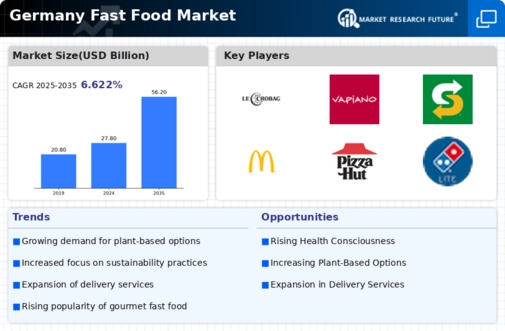Changing Consumer Preferences
Consumer preferences in Germany are evolving, significantly impacting the fast food market. There is a noticeable shift towards convenience and speed, with many consumers favoring quick-service restaurants over traditional dining options. In 2025, around 60% of consumers express a preference for fast food due to its convenience. Additionally, younger demographics are increasingly drawn to innovative menu items and unique flavor profiles, prompting fast food chains to adapt their offerings. This dynamic landscape suggests that the fast food market must remain agile, continuously innovating to meet the diverse tastes and preferences of the German consumer base.
Cultural Influences and Globalization
Cultural influences and globalization are significant drivers of the fast food market in Germany. The influx of international fast food brands has diversified the market, introducing new flavors and dining experiences. This trend is particularly appealing to younger consumers who seek variety and novelty in their food choices. In 2025, it is estimated that international brands account for approximately 30% of the fast food market share in Germany. The fast food market must navigate these cultural dynamics, balancing local tastes with global trends to effectively capture the attention of a diverse consumer base.
Economic Factors and Disposable Income
Economic conditions play a crucial role in shaping the fast food market in Germany. As disposable income levels fluctuate, consumer spending patterns on dining out are affected. In 2025, the average disposable income in Germany is projected to rise by 3%, which may lead to increased spending on fast food. This correlation suggests that as consumers have more financial flexibility, they are more likely to indulge in fast food options. The fast food market must remain attuned to these economic indicators, as they directly influence consumer behavior and market demand.
Urbanization and Fast Food Consumption
The rapid urbanization in Germany is a pivotal driver for the fast food market. As more individuals migrate to urban areas, the demand for convenient dining options increases. Urban centers, characterized by busy lifestyles, often lead to a preference for quick meals. In 2025, approximately 77% of the German population resides in urban areas, which correlates with a growing appetite for fast food. This trend is further supported by the increasing number of fast food outlets in cities, catering to the on-the-go consumer. The fast food market benefits from this demographic shift, as urban dwellers seek accessible and affordable meal solutions, thereby enhancing market growth prospects.
Technological Advancements in Service Delivery
Technological advancements are reshaping the fast food market in Germany, particularly in service delivery. The integration of mobile apps and online ordering systems has streamlined the customer experience, allowing for greater convenience. In 2025, it is estimated that 40% of fast food transactions occur through digital platforms. This shift not only enhances customer satisfaction but also increases operational efficiency for fast food establishments. The fast food market is likely to see continued investment in technology, as businesses strive to improve service speed and accuracy, ultimately driving growth in this competitive sector.























Leave a Comment